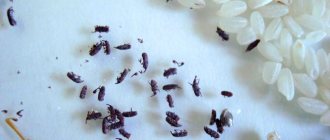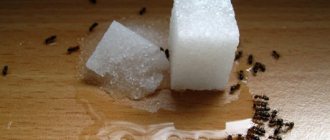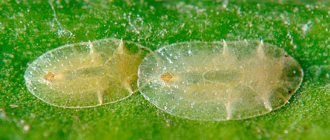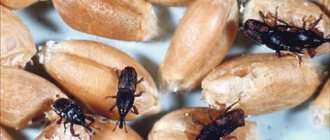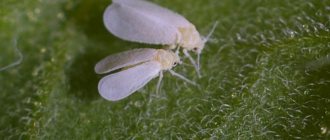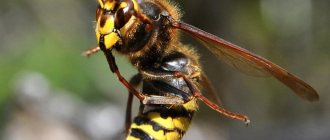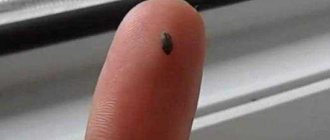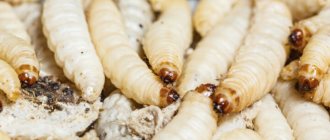Small bugs in the kitchen or pantry mean a lot of problems: a long, but not always effective battle with intrusive pests and a large number of spoiled products. Even the most clean housewives are faced with this disaster on a local scale.
Systematic wet cleaning and checking food lockers will not solve the problem. In order to find out how to get rid of bugs in cereals, you need to understand the reason for their appearance. This is the only way to stop another invasion in the future.
Causes of flour bugs
The most common reason is non-compliance with technological and sanitary standards during food production. Therefore, no one is immune from such a nuisance.
Initially, insects enter the house with dry food, and then quickly spread throughout the kitchen. Pests colonize near food, but are found in cracks, latches and other hidden places.
This is interesting: most insects are so small that they are difficult to notice with the naked eye. They camouflage themselves with the color and shape of the environment in which they live.
In everyday life, bugs appear in cereals or other products if:
- Containers for storing bulk solids are selected incorrectly. Preference should be given to glass and plastic containers with fully screw-on lids or a vacuum effect. An inexpensive alternative is to use plastic bags that must be tied. Limited contact with air and dampness allows you to preserve food longer and prevent insects from accessing it.
- The expiration date has expired. All food products have a specific shelf life. Information about this is indicated on the packaging. Goods sold by weight are fraught with danger, since the actual date of their production and sorting cannot be determined.
- Conditions of detention are not met. A warm, damp atmosphere in a closet or indoors, if we are talking about a pantry, is a favorable factor for the intensive reproduction of cereal bugs. In this regard, air temperature and humidity play an important role when choosing a place to store bulk products.
Advice: it is recommended not to make large reserves unless absolutely necessary, but to limit yourself to moderate volumes and look into the bins more often.
Pest insects like to nest in:
- various cereals;
- pasta;
- flour;
- loose leaf tea;
- granulated or ground coffee;
- dried fruits;
- spices
In order to promptly notice the presence of an “inedible impurity” in a product, you need to know what exactly to look for, that is, what the bugs look like.
Important: the main danger lies not even in food spoilage, but in the allergic reaction or food poisoning that they can provoke.
Why you shouldn't eat contaminated foods
When food is infested with insects, continued consumption may be dangerous. If there were few bugs, then drying and sifting the cereal or flour will eliminate all problems with its quality. But, when the infection was significant, the bugs destroy large volumes of useful substances in the product, including proteins, and instead leave the remnants of their own vital activity:
- excrement;
- chitinous plates;
- cocoons from larvae.
The taste characteristics of such a product are significantly reduced, as is its usefulness for the body. Flour, after being infected by a flour eater, can completely lose its properties - the dough from such a product cannot be kneaded. A negative point is also the risk of food poisoning. It is preferable to throw away products that have been significantly damaged.
What kind of bugs are there in cereals?
The most common types of parasites in the kitchen have different names, but they cause the same harm.
Flour bugs: photo
The red mucoed of Suriname has a brown color. An adult reaches 2 mm in size. In addition to grain processing products, they prefer concentrates, cookies and some cereals in their daily menu. That's why you need to look everywhere.
Insects reproduce quickly and their clutches are impossible to find with the naked eye. Therefore, it is recommended to get rid of the product in which mucoeds were found.
Small Khrushchak
The red-brown flour beetle with small antennae and wings is not able to fly. Body length up to 3 mm. There is a relatively slow pace of reproduction - 4 broods per year. Most of all he loves flour, rice, semolina, buckwheat, millet and Artek waffles.
The colony lives close to food supplies. As a rule, it lives in furniture and dishes.
Important: this type of pest is difficult to remove and easily adapts to any living conditions.
Bread grinders
Insects are cylindrical in shape with a light brown or brown color. They reach 3-3.5 mm in length and are covered with short hairs. The only way to find them in the house is to find them dead on the windowsill. Traces of human activity are found in books, furniture and on shelves. They eat any nuts, cereals, grains, dried fruits and even plants.
food moth
It differs from other representatives of its species, which prefer woolen products, in that it feeds on grain crops and dried fruits. A kind of vegetarian moth.
It reaches a maximum size of 1 cm, looks like a large midge and is enviably fertile - it lays up to 500 eggs in 2 weeks. Eats food at incredible speed, flies and camouflages.
Weevils
Universal pests that eat not only bulk, dry foods and flour products, but also fresh fruits and vegetables. Black beetles grow up to 5 mm long and have a noticeable proboscis. They move freely along walls and fly. They live in containers with provisions, in the corners of closed furniture, and less often in bedding.
Southern barn moths
At first glance they resemble brown moths, but they feed mainly on walnuts, chocolate and dried fruits. If there is a large amount of dried apples, these pests will first turn their attention to them. Slices of fruit turn into dry lumps wrapped in silk with an unpleasant odor.
When looking for fires, you should pay attention to the ceilings of closets or rooms. After hatching, the caterpillars prefer to pupate in such places.
Can there be cockroaches in cereals?
These most popular and intrusive pests also feed on bulk dry foods. But they usually start in the house differently than, for example, flour beetles or bread borers. They are primarily scavengers and feed on food scraps, living near sinks, bins and cutting tables.
Types of kitchen parasites
The following pests can appear in the kitchen:
- Bread borer - small (length - 3 mm) light brown insects. They are attracted to book bindings, crushed grain mixtures, coffee, dried herbs, tea, animal feed and dried bakery products (crackers, crackers, cookies, biscuits). The bread grinder flies well - it can fly into a window, guided by the light. But most often, bugs enter the house along with store-bought food and animal feed;
- Weevils are small dark brown or black bugs with a long proboscis. Under favorable conditions, they produce offspring up to 6 times a year. Most often they can be seen in packages with buckwheat, pasta, rice, flour and legumes;
- The flour bug is a small insect (4 mm long) with a red-brown body. These pests are brought into the house along with flour and starch. The flour bug easily penetrates into any container. They happily live in all types of flour, buckwheat, rice, semolina, dried fruits, and rolled oats. These insects reproduce incredibly quickly. Eggs are laid not only in food, but also in the crevices of furniture, as well as in home textiles. Hatched individuals are able to crawl throughout the house in search of food;
How to get rid of the flour beetle, read more in this article.
- Food moth - the adult resembles a gray butterfly with a body 10 mm long. The reason for its appearance is inadequate processing and storage of food products. Moths can also fly into the kitchen through open windows. Most often it settles in packages of tea, pasta, cocoa and dried fruits. Infected products are covered with a thin cobweb; yellow worms appear in them;
- Red flour beetles are miniature bugs (length - 2.5 mm), the source of infection of which is low-quality grain food for pets. It is a frequent inhabitant of bakeries, mills, and factories. They like to eat grains, cereals and spoiled flour with a moisture content of more than 15%. Unable to find suitable food, the red mucous eater dies.
These photos will help you recognize these bugs.
Attention! If there is a strong infestation of bugs, the nutritional value of the food is reduced to zero. Together with insects, bacteria settle in them, which can lead to allergies and food poisoning.
How to get rid of bugs in cereals in different ways
If pests are found in cereals or other products, you need to start fighting them immediately. The simplest way is to dispose of spoiled food. You should pour everything into a bag, tie it tightly and place it in another one of the same kind.
Important: after some of the supplies have been thrown away, a thorough cleaning is carried out, that is, wet cleaning of all kitchen furniture and treatment with vinegar, soda or bleach.
When bugs in cereals have become a real problem and are not eliminated by throwing away the affected products, you have to resort to radical measures.
How to prepare bait from borax or boric acid
If there are insects in cereals, one folk recipe for homemade bait will help:
- You will need borax or boric acid, semolina and powdered sugar. Mix everything in equal quantities.
- Sprinkle the resulting mixture on all horizontal surfaces. Particular attention should be paid to the place where the pests were found.
The flour-eating beetle dies immediately. Other bugs, larger ones, still run around, but will inevitably die. Insects cannot tolerate boric acid, and sweets will attract them to the trap.
Important: this method can be dangerous if there are pets or a child in the house. The active substance, once in the mucous membrane, will cause severe irritation, and through the oral cavity - poisoning.
Thermal fighting
Small insects do not tolerate sudden changes in temperature, frost and heat. If you find pests in winter, it is enough to take the cereals out onto the balcony. But at the same time, the mercury column should show no higher than -15 °C. After a couple of hours, all insects will die. This method is especially relevant in order to remove beetles that have taken up residence in flour or semolina, but at the same time preserve food.
For cereals, the opposite method is suitable - exposure to heat. Pour the product onto a baking sheet and place it in the oven. At a temperature of +50 °C, the uninvited “tenants” will die within 15 minutes. But to be sure, they recommend holding it for 30 minutes.
Exposure to water and sun
When there is no time or suitable conditions, an alternative option is suitable: take the amount of cereal needed for cooking and add hot water. This method is suitable for quickly ridding pasta and bulk food products of most small insects. The pests will float up dead, just drain them and repeat the procedure.
When bugs appear in flour, it is not immediately possible to determine what to do with the ingredient for many dishes. It's a shame to throw away a large amount. There is a way out of this situation: you need to take it outside. Mucoeds are afraid of ultraviolet radiation. Under the influence of sunlight, they will run away after 10 minutes. But don't relax. It will not be superfluous to sift the purified product twice.
Salt
Washing cereals with salted water gives good results. All pests float to the surface, but after this you need to repeat the procedure with regular liquid without impurities. The method is even suitable for oatmeal, but it must be cooked immediately.
Table vinegar
Used for wet cleaning after getting rid of insects. The pungent odor of the substance will protect against new pests and drive away those remaining after persecution. Surfaces are treated with a solution of laundry soap, vinegar essence and boiling water.
Strong odors
All insects are afraid of strong odors. They are not able to destroy pests, but will drive them away for a while. Garlic, bay leaves, dry lavender, wormwood and sage will cope with this. The herbs are laid out after thorough wet cleaning in the former habitats of the bugs.
Methods for getting rid of black bugs in the kitchen
If you find bugs in the kitchen, take the necessary measures to destroy them:
- Identify and correct the source of the problem. Empty the cabinets and review all supplies of cereals, flour, dried fruits, tablets, tea and coffee. Place spoiled food in a bag and place it in the trash.
- Inspect the kitchen furniture, window sill and household appliances - sometimes uninvited guests are found in such unusual places.
- Wash food storage containers with soda solution.
- Wipe the doors and shelves of cabinets in the kitchen with a cloth soaked in a solution of vinegar (1 tablespoon per 1 liter of water) or detergent.
- Seal or seal any cracks that are discovered during cleaning.
- Pack the remaining intact cereals in an airtight glass container and take them outside the kitchen for 10-14 days. If no insects appear in them during this time, they can be eaten.
A prerequisite for getting rid of bugs in cereals is to thoroughly treat cabinets, shelves and other surfaces in the kitchen with a vinegar solution. This disinfection is safe for humans, but effectively repels pests.
Products that could be contaminated with parasites are subject to special treatment. The following methods are used for this purpose:
- exposure to ultraviolet radiation;
- exposure at high temperatures in the oven (10 minutes at a temperature of +100…120 ℃);
- exposure to low temperatures during the day (in the freezer).
Folk ways to fight bugs
To combat bugs in the kitchen, products with a bright aroma are used. Pests are repelled by the smell of bay leaves, lavender, garlic, wormwood, borax, vinegar and nutmeg. To get rid of pests, place any of them on the shelves of the closet and do not forget to change them periodically.
Traps that you can make at home will help you get rid of pests:
- Combine borax and powdered sugar in equal proportions.
- Pour the mixture into the lid and place the trap near the pest habitat.
- Check the bait regularly and refill it if necessary.
Bay leaf is an affordable, safe and effective means of repelling insects from cereals, tea, dried fruits and other food products.
Chemicals in pest control
When folk remedies do not help cope with pests, perform chemical treatment of the room. The method is used in exceptional cases with large-scale damage.
When using chemicals, observe safety rules and follow the instructions for use indicated on the packaging. Avoid contact of active substances with skin, eyes, respiratory organs and food. Carry out the treatment when there are no children or pets in the room, and after disinfection, ventilate the kitchen well.
Treating cabinets with chlorine-containing products (Domestos, Belizna, etc.) will help you deal with bugs in the kitchen. Wipe all shelves, walls, cabinet doors and leave the room to ventilate for a couple of hours. After a day, repeat the treatment.
Other means to combat bugs in cereals and in the kitchen:
- pyrethrum powder. Sprinkle the product where you store food and after a couple of days you will forget about pests. The insecticide is safe for pets and people;
- "Lovin Fire Protection". An effective poison for flour eaters and bread grinders. When using the product, wear a respirator, as its fumes are dangerous to humans;
- "Anti-bug." Treat wooden surfaces with a special protective agent - it will not only get rid of pests, but also prevent their occurrence in the future. Be careful when working with the product, as it is dangerous if it comes into contact with the skin or mucous membranes;
- "Rogneda". The drugs of this brand are effective in combating various pests - bugs, ants, flies, fruit flies, cockroaches.
Wild chamomile (pyrethrum) repels pests with its aroma. Place a small bouquet or bag of powder on the kitchen shelves and you don’t have to worry about your cereal supplies
According to consumer reviews, proven Dichlorvos will help remove bugs forever. Procedure for using the aerosol:
- Hide all food products and throw away spoiled products.
- Wash cereal containers and all kitchen cabinets.
- Make sure there are no pets or children in the room. Take personal safety measures - wear a respirator or bandage.
- Spray the room with an aerosol and close the kitchen for half an hour. Then turn on the hood and open the window to ventilate the apartment well.
After treating the room with chemicals, vacuum all shelves and floors, as there may be dead cereal pests lying on them.
How to fight and get rid of insects using chemical means
You can get rid of insects in an apartment not only with folk remedies. But chemicals cannot be used to clean cereals, as they pose a danger to humans. Once in the body with food, the toxin can cause acute poisoning, at a minimum.
Insecticides in the form of emulsions and aerosols are sprayed in rooms from which all products have already been removed. The procedure is usually carried out as one of the points in a comprehensive pest persecution plan. After treatment, it is forbidden to stay in the room for some time if it is not ventilated, but food cannot be stored for even longer.
The only substance of this type that is relatively safe for humans is Pyrethrum. The natural insecticide is based on Dalmatian chamomile and is often used to treat indoor plants.
Important: the use of chemicals is carried out exclusively in accordance with the instructions on the packaging.
Where do insects come from?
Pests can settle in bulk products for three reasons.
- Uncleanliness of the housewife. Unsanitary conditions in the kitchen are the least likely cause of “uninvited guests.” Even if you do general cleaning every day, you cannot be guaranteed to protect yourself from pests: insects can be brought into the house along with purchases from the store.
- Dishonesty of suppliers. Factories do not always comply with sanitary control requirements: storage conditions are often violated, and products do not undergo the necessary heat treatment. As a result, the housewife buys cereals that already contain pests.
- "Dangerous neighborhood." Insects can “immigrate” into cereals from nearby stocks of tea, herbs, pasta, dried fruits, and seasonings purchased by weight.
Is it possible to eat contaminated cereals and flour?
Some people are disgusted to even touch such a product, let alone consume it, because we are talking about health. It is not recommended to use spoiled cereals for making porridge.
Even after washing, eggs, larvae, their husks and excrement may remain. All this will not bring any benefit; moreover, it can cause unpleasant consequences in the form of poisoning or allergies.
It's a little easier with flour. Using a fine sieve can get rid of all this debris. The final disinfection of flour is carried out using an oven at a temperature of +50 °C.
Most common places
Don’t think that bugs only love tasty things: cereals and sugar.
These are such omnivorous creatures that you can find them anywhere, even in packages (sealed!) with mustard plasters.
And also in spices, including red pepper.
And since they feel great in such a place, you yourself understand that folk remedies that include something burning in their composition will not help you. But, more on that later, for now let’s identify the most likely places of their deployment, since we need to act quickly and surely.
Carefully inspect all bags of cereals. Start looking for nasties in open packages, that’s where they get in most often. If there are a lot of them there, then you can be sure that they have already managed to penetrate into closed ones, you just can’t see them yet, because the holes they gnaw are very small.
Inspect all dry provisions, as they can be not only in cereals, but also in flour, pasta, and sugar.
Maybe they don’t like salt, but look anyway, it won’t hurt. Maybe you have some special salt-eating bugs? It’s better to be on the safe side in this matter, because as soon as you leave their “nest” somewhere, you won’t even have time to blink an eye before they fill the kitchen again.
Beans are the best “house”. Why exactly the bugs love her so much is not very clear, but the fact remains. If beans are not stored in the freezer, but simply in a jar or bag, then sooner or later they will have to be eaten by beetles.
Most likely, it is in the beans that some special bugs appear, the larvae of which were already in it before, they just “sleep” until a certain moment. And as soon as they get into the heat, they immediately begin to turn into bugs, which leave dark, large spots and holes on the grains.
Or maybe some stray parasite gets into the beans from the field and then quickly multiplies? It’s not very clear, but that’s not the point.
Beans are the most vulnerable, so make it a rule to keep them in the freezer.
This is the most ideal storage place. After freezing, the quality of the grain does not change at all and it can even be planted; it germinates perfectly.
Sort through spices and medicines. As we already wrote above, bugs simply adore mustard plasters. Although it’s bitter, it’s still some kind of torment. So, look, are they there? Also, open the packages of patches, tablets and thoroughly wipe the cabinet itself. Maybe they will crawl out when you start rustling in the box. And spices - peppers, seasonings, all kinds of herbs. They could be anywhere!
Tea, coffee, dried fruits are also their favorites. Usually, it is precisely these things that housewives forget most often. They are practically invisible in the bank. They only float up when you pour the drink. This is a very disgusting sight! Therefore, look, otherwise, the hour is uneven, you will embarrass yourself by pouring tea for a guest.
Pay attention to the boxes with vegetables. Imagine, bugs even love onions
There are many posts on forums online where women say that pests have appeared even there. At the same time, the onion deteriorates and becomes soft. Therefore, don’t be lazy and inspect all the vegetables.
Look behind furniture walls and into crevices. Bugs are different. Some are cereal, and some are furniture. They are not particularly interested in provisions, but they are great at cruising around the kitchen, making crap and spoiling the mood with their appearance.
They thrive in kitchen cabinets, feeding on crumbs. In addition to kitchen furniture, open drawers in other rooms. If there are already a lot of them, then they could easily spread throughout the apartment.
Check the window sills. The kitchen window sill is especially vulnerable. Housewives often use it as an additional workplace. Therefore, there may be all sorts of tiny things in the cracks, behind which bugs will stick. And there they will make a “den” for themselves.
Take a good look at the floor. They can also have a great time there. Especially if your floors are wooden and have many small cracks. They are not so easy to spot on the floor. Here you need to either etch them with steam or wipe them with bleach. Then they jump out, and you will already know where to chase them from.
Clean out all household appliances. Surprisingly, bugs even occupy equipment. They can be found in mixers, meat grinders and even irons.
One woman on the forum wrote that she found bugs when she started ironing her blouse. Turn on the steam and they will fall out... Brrr...
So, don't forget to take a look. It will be very disappointing if you start making minced meat and there are bugs in it.
General cleaning as a method of pest control
Pests can also be removed by thoroughly cleaning their habitat. But subject to the obligatory condition of disposal of affected products.
What do we have to do:
- Empty the cabinet or shelf of its contents. Clean everything inside with a soapy vinegar solution. Pay special attention to food residues that often spill out in storage areas.
- Pour boiling water over all containers.
- Wash fabric bags in salt water.
- For adult individuals, it is better to use special traps.
Plants with a pungent odor also show good results in the fight against insects. These include mint, lavender, lemon balm and others. Soaking cloth strips in extracts will help prevent a new insect infestation. The main thing is not to forget to update your feeds.
How to remove insects from kitchen furniture?
If there are bugs not only in food, but also in furniture in the kitchen, you need to urgently take measures that will allow you to get rid of not only adult individuals, but also larvae and clutches of eggs.
Step 1. Empty all cabinets of boxes and bags of cereals.
Step 2. Immediately flush any spilled food down the toilet - it may contain parasite eggs.
Step 3. Wipe the surfaces with water and vinegar (1 tbsp per 1 liter of water).
Step 4. All holes and cracks must be filled with boiling water.
Step 5. Wash jars for storing flour and cereals with soap and rinse with very hot water.
Step 6. Wash textile bags in saline solution and dry without rinsing. After this treatment, the bugs will no longer be able to lay eggs.
Step 7. Pyrethrum (Persian chamomile powder), a natural insecticide that allows you to fight household pests without harming your own health, will also help remove insects. It is scattered inside cabinets or poured into fabric bags. Repeat treatment once every 1.5 weeks.
Step 8. You can use bait to lure kitchen bugs out of secluded crevices. There are several recipes for their preparation.
Recipe 1. Mix powdered sugar, borax and fine grains. Place a small amount of the mixture on sheets of paper and place them around the kitchen.
Recipe 2. Combine powdered sugar with borax and millet, crushed in a coffee grinder (take everything in equal quantities). Roll small balls, dry them slightly and place them in cabinets.
Recipe 3. Mix sugar, borax and dry yeast. Pour the composition onto pieces of paper and place on the shelf.
Step 9. The best remedies for food moths are lavender and wormwood. You can use both the plant itself and essential oil. In the first case, small bouquets are made from fresh or dried twigs, in the second, a piece of cotton wool is soaked in essential oil. Anti-bug esters also include basil, geranium, cloves, fir and rosemary.
Step 10. Most beetles are afraid of sunlight. When you come home from the store, pour the cereal into glass jars without lids and place them on the windowsill.
Interesting! Most often, parasite larvae infect goods sold by weight on street stalls. Refrain from such purchases in favor of packaged groceries.
Prevention of occurrence
It is easier to avoid the appearance of any insects with the help of simple manipulations than to then spend a lot of time and effort fighting them.
Tips on how to prevent beetles:
- When buying bulk products, look at the production date and expiration date.
- Check the packaging for integrity.
- If possible, inspect the product for quality (presence of debris) and the presence of living creatures in it.
- Regularly clean food storage areas.
- It is better to keep bulk products in plastic or glass, but always transparent containers. This makes it easier to control the presence of inedible additives in it.
By taking standard precautions when purchasing food, you can protect your home from insect infestations. You should not stock up on cereals, flour, or pasta for future use. Large amounts of food are harder to keep track of.
Did you like the article? Save it to your Pinterest! Hover over the image and click “Save.”
Application of these creatures
The stoneweed, like the hruschak, is just a pest for many.
But avid fishermen, as well as owners of birds and amphibians, know about the beneficial purposes of larvae. Reptiles, birds, amphibians, and invertebrates eat them with great pleasure. When using larvae as food, you should remember that this is a very high-calorie treat. For example, if you give budgies more than five birds a day, your winged friend can quickly gain excess weight, which, combined with inactivity, leads to obesity. Another purpose of the bonefish is as bait or bait. Fishermen are guaranteed a good catch of roach, chub, rudd and other non-predatory fish. Thanks to its fairly hard shell, the larva does not fly off, holding tightly to any hook. It is used in both bottom and float fishing, as well as in floating equipment.
Mealworms are a commodity in high demand in poultry markets, pet stores and, of course, among fishermen. You can purchase it regularly, even stock up. The larvae are stored for a very long time, up to several weeks. The main thing is to follow simple rules: temperature conditions, good ventilation. But there is another win-win option for those who use boners constantly or want to earn extra money. Cultivation at home. This process does not require large financial investments and physical and time costs.
Types of bugs
Not only are the beetles fertile and camouflage their eggs, but they also come in many varieties. Insects have different food preferences, living conditions, and reproduction rates. Accordingly, the methods of dealing with them also differ. So, is it really difficult to exterminate them? Let's figure out in order what the different types of bugs are called and why they are interesting. Look at the photos and look for people you know.
Bread grinder
This is a red bug that lives in buns, cereals and tea. He’s a good flyer, but he won’t leave the apartment of his own free will, so the fight with him promises to be long.
Weevil
A black insect with a long proboscis, unpretentious to food and habitat. It flies poorly, but this does not prevent it from moving. The weevil can live for a long time without food, so it is useless to starve it.
Suriname mucoed
A small red bug that lives in spoiled cereals and is not averse to eating sweets. Very prolific, but cannot stand the test of hunger and unusual conditions.
The flour bug lives in oatmeal, semolina and flour
Probably familiar to many - this is a long (up to 4 mm) dark brown creature that spoils oatmeal and semolina cereals and flour. Its eggs also look like white grains, and therefore are not easy to detect.
